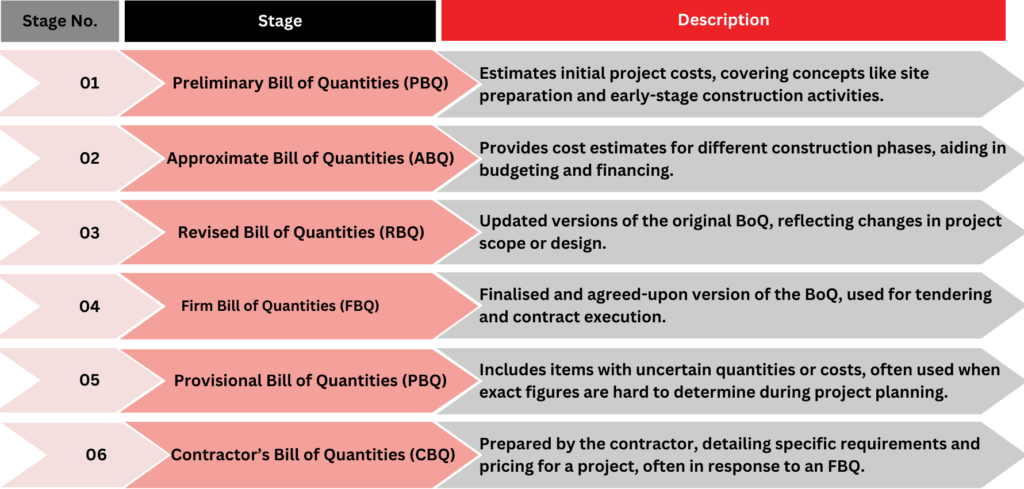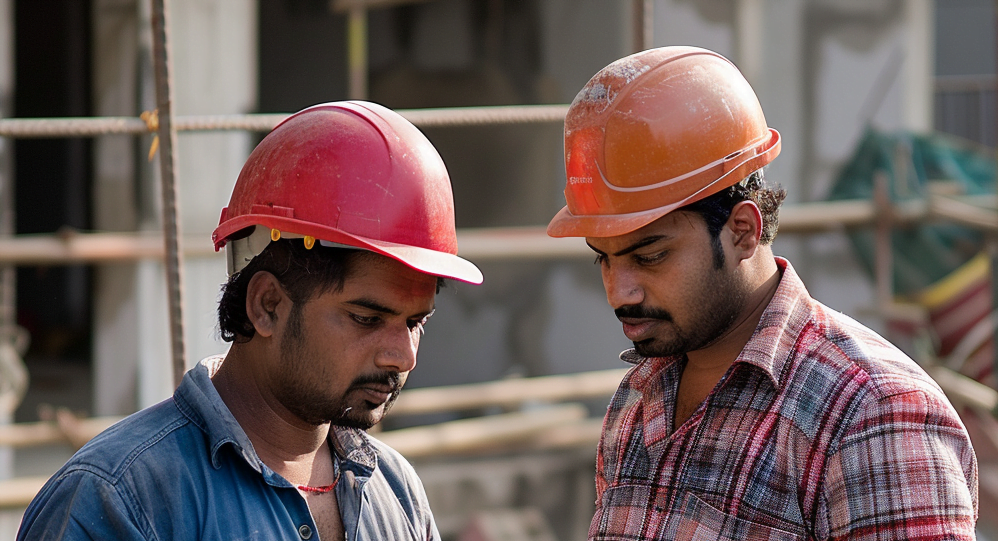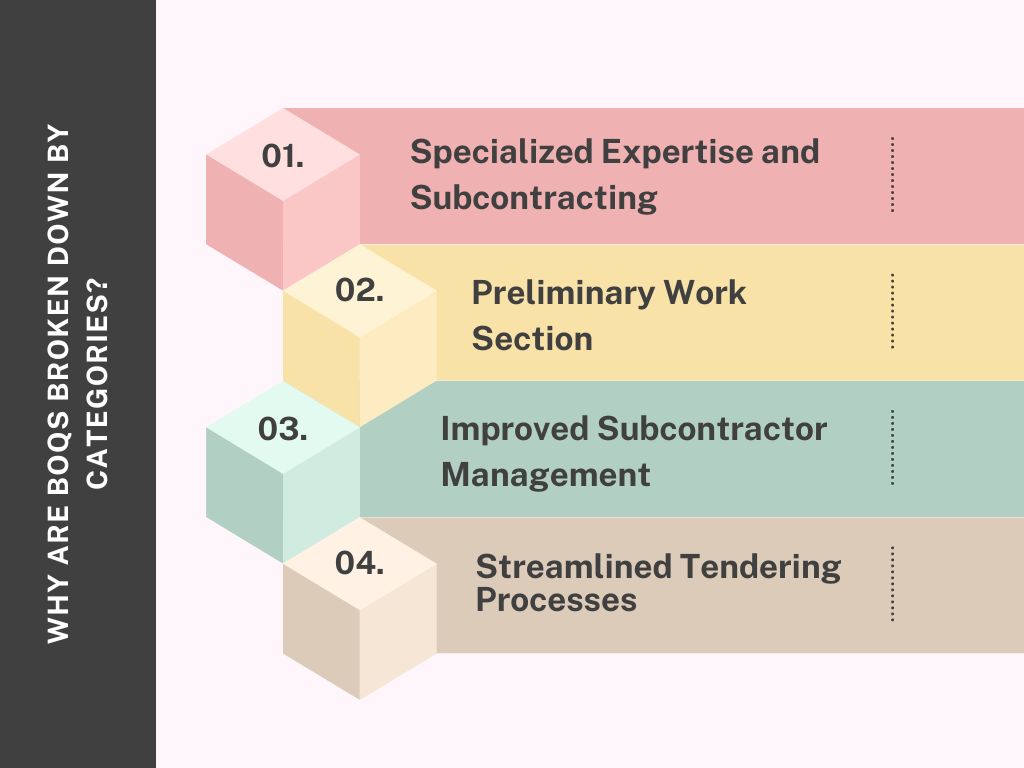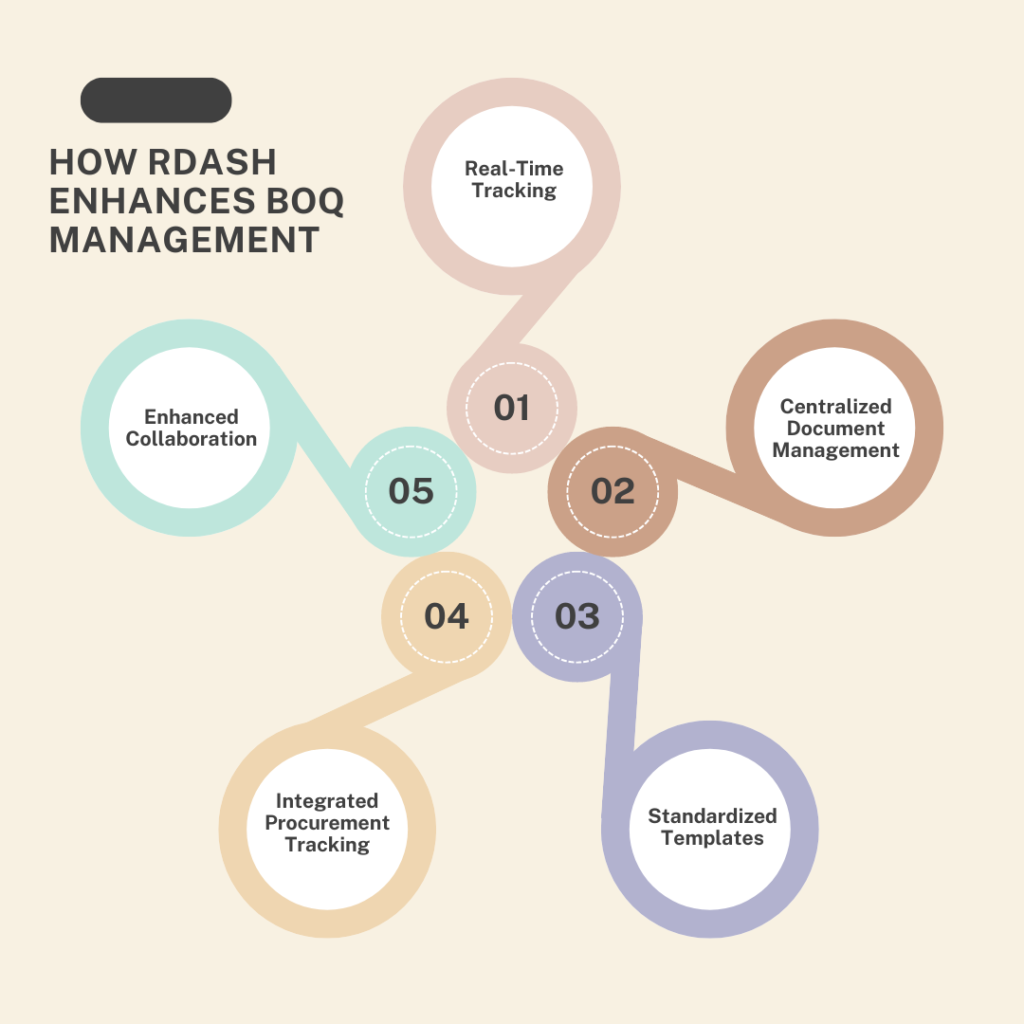A Bill of Quantities (BOQ) is a crucial document in construction, used during tendering to list all materials, labor, and costs required for a project. Created by a cost consultant or quantity surveyor, it ensures all contractors price the same quantities, promoting fair competition. The BOQ details quantities for various work activities and breaks down the project into components like foundations, roofing, finishes, and more. It aids in cost calculation, budgeting, and serves as a communication tool among stakeholders, ensuring a clear understanding of the project scope. The BOQ is vital for managing and tracking costs during construction, supporting valuations, handling variations, and preparing final accounts. Its use has evolved since the 18th century, becoming essential for efficient project management.
Types Of Bill of Quantities
Construction often employs a range of BoQ variants. The most prevalent kinds are:
| S.No | Type of BoQ | Description |
|---|---|---|
| 1 | Elemental Bills of Quantities | Divides the BOQ into building elements arranged in the sequence of construction activities, such as constructing walls before plastering and painting. |
| 2 | Trade Bills | Categorizes work sections by trades, grouping items like “Excavation and Filling” and “Brick or Block Walling” in functional order based on specific trades. |
| 3 | Operational Bills | Breaks down work into site operations, detailing labor and plant requirements along with material schedules for each operation. |
| 4 | Activity Bills of Quantities | Further development of operational bills, integrating labor, plant, and materials into sections based on activity sequencing from network analysis to ensure logical progression of tasks. |
| 5 | Annotated Bills | Includes notes to clarify work locations on drawings, aiding transparency and identification of measured and described work items. |
| 6 | Provisional Bills of Quantities | Contains provisional or approximate quantities issued to tenderers with the understanding that actual quantities will be remeasured during construction, allowing early commencement of work even when final drawings and specifications are incomplete. |
| 7 | Itemised BoQ | Provides a detailed breakdown of all required materials, equipment, and labor, with exact quantities specified for each item, offering the highest level of accuracy. |
| 8 | Abstract BoQ | Summarizes total quantities and costs in a condensed format by category rather than detailed items, giving an overall view of the project costs. |
| 9 | Preliminary BoQ | Developed early using approximate estimates to provide a ballpark indication of costs before making final plans, useful for initial project planning and budgeting. |
| 10 | Final BoQ | The most detailed and precise BoQ created at the end of the design stage as the basis for contractor bidding and project delivery, ensuring accurate cost and resource planning. |
| 11 | Elemental BoQ | Organizes quantities and costs by building elements like foundations, walls, doors, etc., rather than traditional trade categories, to reflect the construction sequence more clearly. |
| 12 | Trade BoQ | Categorizes the scope and pricing by trades like electrical, plumbing, framing, masonry, etc., making it easier for sub-contractors to bid on specific sections of the project. |
| 13 | Location BoQ | Divides the project into zones or areas like 1st floor, 2nd floor, East Wing, etc., quantifying materials and labor by location to facilitate phased construction and cost management. |
Format of Bill of Quantities
The main sections included in the bill of quantities are:

- Form of Tender: Outlines contractual terms and conditions.
- Information: Provides project details and context.
- Requirements: Specifies materials, parts, and labor needed.
- Pricing Schedule: Lists rates per unit and total amounts.
- Provisional Sums: Allows for adjustment of approximate quantities.
- Day Works: Addresses additional or unforeseen tasks.
- Item Description: Detailed work/material/service descriptions.
- Unit: Specifies measurement unit for each item.
- Quantity: Quantifies amount/volume of each item.
- Rate per Unit: Cost per unit of item.
- Total Amount: Calculates total cost per item
The format of a Bill of Quantities (BoQ) is designed to comprehensively capture the essential elements for accurate cost estimation and project planning in construction. It encompasses diverse items such as materials, labor, equipment, and services, covering various construction activities like excavation, concrete works, and electrical installations. Each item is associated with a specific unit of measurement, ensuring precise quantity assessment from project drawings and specifications. The BoQ serves as the basis for cost calculation, with rates multiplied by quantities to determine total costs. Detailed breakdowns include labor, material, and subcontractor costs, aiding stakeholders in budgeting and project management.
How to prepare Bill of Quantities
Various stages of Bill Of Quantities:

Guide for Creating Bills of Quantities:
- Initial Project Documentation: Gather all pertinent project documents, such as architectural plans, engineering drawings, and specifications, to establish the groundwork for your BoQ.
- Itemization and Categorization: Scrutinize the project documents meticulously, listing all necessary materials and labor. Categorize these items as either materials or labor, providing concise yet detailed descriptions for clarity.
- Quantification with Costs: Utilizing the project specifications, quantify all required items and their associated costs. Calculate the total project costs and estimate the total man-hours needed for completion.
- Quality Control: Conduct a thorough review and cross-check of your BoQ to ensure accuracy and consistency. Engaging multiple reviewers can help eliminate errors and discrepancies, ensuring precision.
- Final Compilation: Organize the BoQ in a clear and easily understandable format, including a cover page with project details and any necessary terms and conditions. This final compilation ensures accessibility and clarity for all stakeholders involved in the project.
Importance and advantages of Bill of Quantities
Certainly, here’s a combined paragraph with bullet points for both the importance and advantages of Bills of Quantities (BoQ):

- Crucial for Cost Estimation: BoQs play a pivotal role in accurately estimating project costs by detailing material and labor quantities required, aiding in budget preparation and financial planning, thus ensuring projects stay within financial constraints.
- Streamlined Tendering Process: BoQs are essential during tendering as they provide standardized information for contractors to base their bids on, ensuring fairness and transparency in the selection process, while also simplifying bid analysis and aiding in contractor selection.
- Enhanced Quality Control: By specifying materials and standards, BoQs contribute to quality control, ensuring compliance with project specifications and regulations, thereby maintaining high standards throughout the construction process.
- Simplified Bid Analysis: BoQs streamline bid analysis, promote fairness, speed up the tendering process, enhance accuracy, enable cost control, facilitate contract management, and provide valuable data for future projects, making them indispensable tools for construction project management.
Applications of the Bill of Quantities

Bill of Quantities can be utilised as follows:
- Streamlining the tendering process: Tendering in construction projects is critical for fair comparison among various offers. By issuing a Bill of Quantities to bidding contractors, project owners ensure that all quotes are based on the same work items and quantities, promoting fairness and transparency.
- Utilizing Bill of Quantities in Construction: Following the selection of a contractor, it serves as a tracking tool throughout the construction phase. It can be integrated with the project schedule for cost planning and progress monitoring.
- Progress Reporting: Contractors input completed work as partial quantities in the BOQ spreadsheet, automatically calculating monetary values based on unit prices. This enables accurate tracking of project expenses and facilitates interim payment calculations.
- Payment Management: Interim payments can be calculated by comparing progress reports, with deductions for advance payments and retainage. The BOQ ensures clarity in payment processes, reduces disputes, and enhances financial management.
- Project Completion: At project completion, the BOQ is reconciled with actual work quantities to identify any discrepancies. This informs final payments, with adjustments made for variations between planned and actual work, ensuring fairness and accuracy in project cost assessment.
- Cost-Efficiency: By providing detailed pricing for CAD services, including turnaround times and pricing tiers based on project size, the use of BOQs promotes cost-efficiency and effective resource allocation in construction projects.
- Proactive Problem Identification: Understanding the scope of work and details beforehand enables proactive problem identification, helping to mitigate construction challenges and enhance project success rates.
What does BOQ include?
A BOQ typically includes:

- Itemized Work List: Covers architectural, structural, mechanical, electrical, plumbing, fire protection, etc.
- Quantity of Work: Specifies the amount of work for each item, along with the measurement unit.
- Unit Price: Contractors calculate a unit price for each item, encompassing all costs.
- Total Price: The BOQ calculates the total cost for each item by multiplying quantity by unit price.
- Categorization and Subtotals: Items are categorized by areas, with subtotal prices for each category.
- Clear Language: Uses clear language for easy understanding by both technical and non-technical professionals, with additional technical details available in construction drawings and specifications.
Why are BOQs broken down by categories?

- Specialized Expertise and Subcontracting: General contractors, overseeing projects, often lack specialized expertise for every aspect, leading them to engage subcontractors for specific project components such as HVAC, electrical installations, plumbing, and fire protection.
- Preliminary Work Section: BOQs typically include a preliminary work section outlining essential activities to initiate the project, such as site cleaning and setting up temporary facilities. For remote projects, preliminary works might involve constructing temporary accommodations for project personnel unable to commute daily to the site.
- Improved Subcontractor Management: Categorizing items in the BOQ makes the document more manageable, enabling general contractors to easily divide it into smaller sections for subcontractors. Each category represents a distinct aspect of the project, allowing subcontractors to focus on their specialized areas, leading to more accurate pricing and efficient bid submissions.
- Streamlined Tendering Processes: Categorisation streamlines internal tendering processes for each bidding contractor. Subcontractors can readily identify and price specific work items relevant to their expertise, enhancing the overall efficiency of the bidding and project management processes. Thus, breaking down BOQs by categories not only simplifies subcontracting but also enhances the organization and effectiveness of the tendering and project execution phases.
Common errors in BOQs
Errors to Avoid in Bill of Quantities (BOQ) Development

- Inaccuracies in Measurement and Description: Ensure precise measurement and detailed descriptions for each item of work to prevent ambiguity and misunderstandings.
- Irrelevant Preliminary Items: Avoid including irrelevant preliminary items, as this can lead to discrepancies in scope and unnecessary costs.
- Omissions and Discrepancies: Be vigilant about inconsistencies between the BOQ and the drawings or specifications, ensuring accuracy and alignment.
- Errors in Pricing: Exercise caution to avoid errors in pricing, such as incorrect understanding of work methods, reliance on past performance, or overlooking the relationship between items of work.
- Inadequate Detailing: Provide comprehensive detailing to avoid confusion and inaccurate cost estimations, ensuring clarity and precision in the BOQ.
- Lack of Price Research: Conduct thorough price research to ensure that pricing information used in the BOQ is up-to-date and reflective of market trends.
- Neglecting Subcontractor Quotes: Incorporate subcontractor quotes into the BOQ to accurately assess project costs and prevent budget discrepancies.
- Overlooking Design Changes: Regularly review and update the BOQ to account for design changes, ensuring accuracy and alignment with project requirements.
By avoiding these common mistakes and adhering to best practices in BOQ development, you can ensure accurate and comprehensive documentation for your construction projects.
How RDash Enhances BOQ Management
RDash is a cutting-edge construction management app designed to streamline various aspects of project management, including BOQ management. Here’s how RDash can boost efficiency in managing a BOQ:

- Real-Time Tracking: RDash provides real-time tracking of BOQ line items, allowing project managers to monitor status updates and approvals seamlessly. This feature helps in identifying and addressing any issues promptly, minimizing revenue leakage.
- Centralized Document Management: With RDash, you can create and manage a centralized element library. This ensures consistency in item descriptions and formatting, reducing errors and improving overall accuracy in the BOQ.
- Standardized Templates: RDash offers customizable templates for BOQs that can be standardized across projects. This standardization helps in maintaining uniformity and efficiency in BOQ preparation.
- Integrated Procurement Tracking: RDash includes a procurement tracker that integrates with the BOQ, allowing you to monitor procurement status and costs effectively. This feature ensures that all critical items are procured on time, reducing the risk of project delays.
- Enhanced Collaboration: RDash facilitates better collaboration among team members, clients, and contractors. It provides a platform for documenting changes, sharing updates, and communicating effectively, ensuring that all stakeholders are on the same page.
Conclusion
A well-managed Bill of Quantities is crucial for boosting project management efficiency in construction. By addressing common pain points such as revenue leakage, incomplete scope descriptions, and project delays, and by implementing remedies like status tracking and standardized templates, project managers can significantly enhance their project outcomes. RDash, our innovative construction management app, offers robust features to support these practices, ensuring accurate BOQ management and seamless project execution.
By leveraging RDash, construction professionals can streamline BOQ management, improve cost control, and ultimately achieve greater project success. Embrace the power of RDash to transform your approach to BOQ management and drive efficiency in your construction projects.






